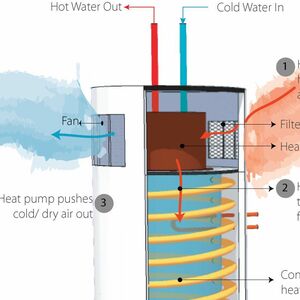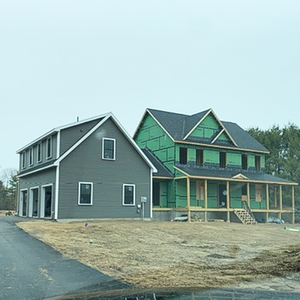
As a runner, I’ve had some direct experience with temperature regulation in the human body. In winter (and we’re having a real one this year in Atlanta), I’m always faced with the choice of how to dress for the conditions I’ll encounter during a run. It usually comes down to whether I want to be uncomfortable at the beginning or at the end. Put on enough clothing to be comfortable at the start, and I’ll be stripping down and figuring out how best to carry the extra layers once I get warmed up. Put on just enough to be comfortable later in the run, and I’ll suffer being too cold when I set out.
If you’re wondering what this has to do with homes, let me state for the record that building science is really more about people than about buildings. If you don’t understand how the human body responds to its environment, you can’t understand what we need buildings to do. And that brings us back to my running in the cold experience and, of course, Led Zeppelin. They clearly understood human thermoregulation better than most rock bands. You might say they had a whole lotta love for the subject. (Yeah, I really did that. Sorry.) In their words:
You need cooling
Baby I’m not fooling
I’m gonna send ya
Back to schooling
Misconception #1: Winter cooling
The first misconception about human thermoregulation is that we need to cool off in summer and warm up in winter. Right? The language we use to describe keeping our bodies comfortable in winter isn’t accurate. We don’t need to warm up (most times anyway). If you fall through the ice and are stuck in a freezing-cold pond for a few minutes, your body cools too much and you do need to warm up. It’s called hypothermia, and it can kill you. But that’s clearly an extreme scenario, not the norm.
Under normal circumstances, our bodies need constant cooling—even in winter. That’s because the human body is a lot like an internal combustion engine. It takes in fuel, puts it through chemical transformations, and generates heat. It’s easy to understand our need for cooling in summer. In winter, too, we still need to cool. It’s just that we need to shed less heat than in summer because the surrounding environment is cooler, providing a kind of hidden cooling.
So we regulate the amount of cooling our bodies do in a number of ways. As I mentioned at the beginning, one method is with clothing. We add or remove layers to adjust the rate of cooling. Another part of my running example is important, too. The amount of cooling we need changes with activity level. If you’re sitting in a chair reading a book, you may need a couple of layers plus a sweater in a cool room. Go out for a run on chilly day and you may be OK with shorts, a long-sleeve shirt, and no gloves. Or go jump on the bed for a while, and you’ll be stripping down to your socks.
The human body cools primarily through the skin, and scientists have found that the person reading in a chair generates about 350 BTU per hour of heat. Scaling that for the average adult, it’s about 18.4 BTU/hr per sq. ft. of skin area. If you’ve ever used the cardio machines at the gym, you may have seen that they tell you your output in calories, watts, and mets. Well, now you know what a met is: 18.4 BTU/hr/sf.
Misconception #2: Psychology
The other misconception about human thermoregulation and comfort is that it’s an objective factor that can be calculated. Certainly, we can quantify heat loss from the human body. Just take a look at chapter 9 in the ASHRAE Handbook of Fundamentals. You’ll see equations for the energy balance between the body and its environment, heat storage, sensible heat loss from the skin, evaporative heat loss from the skin, respiratory losses, and more. Oh, we know how to quantify this stuff!
But don’t gloss over that very first sentence in chapter 9: “A principal purpose of HVAC is to provide conditions for human thermal comfort, ‘that condition of mind that expresses satisfaction with the thermal environment and is assessed by subjective evaluation.'” Did you catch that? Thermal comfort is a “condition of mind” that is “assessed by subjective evaluation.” That quote within the quote, by the way, is straight from ASHRAE’s thermal comfort standard.
The point here is that comfort is about more than the type of insulation in your walls and the type of heating and air conditioning system you have. It’s about the human body and the mind. A good building enclosure and a well-designed mechanical system can go a long way to helping you be comfortable, but in the end, other factors are just as—if not more—important.
Now, it’s time for me to put on some Led Zeppelin II and go run a few miles. Let’s see, it’s 9° C out there . . . that’s T-shirt and shorts weather.
_________________________________________________________________________
Allison Bailes of Atlanta, Georgia, is a speaker, writer, building science consultant, and founder of Energy Vanguard. He is also the author of the Energy Vanguard Blog. You can follow him on Twitter at @EnergyVanguard. Image credit: SCI Progress.
Weekly Newsletter
Get building science and energy efficiency advice, plus special offers, in your inbox.















0 Comments
Log in or create an account to post a comment.
Sign up Log in